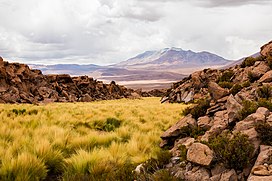|
Olca
Olca is a stratovolcano on the border of Chile and Bolivia. It lies in the middle of a 15 km long ridge composed of several stratovolcanos. Cerro Minchincha lies to the west and Paruma to the east. It is also close to the pre-Holocene Cerro Paruma. It is andesitic and dacitic in composition, with lava flows extending several kilometres north of the peak. The only activity from the ridge during historical times was a flank eruption from 1865 to 1867. The exact source of this eruption is unclear. Gas emissions and compositionThe gasses emission is comprised by a single warm spring at the base[1] and a persistent fumarole field over at the crater's dome for at least 60 years.[2] The fumarolic field is about 0.1 km2 and the emissions measured in situ at the crater show a highly mixed magmatic system between high temperature gasses and hydrothermal fluids. The gas composition indicates low concentration of H2, CO and acidic gasses, and high concentration of H2S and hydrocarbons.[2] The carbon/sulfur ratios are high and the isotopic values suggest the mixture between magmatic, hydrothermal, and atmospheric fluids.[2] Other techniques used to measure the amount of SO2 includes remote sensing techniques called Differential Optical Absorption Spectroscopy(DOAS) giving maximum concentration of 35 ppm.m of SO2;[3] and the most recent taken with a UV camera suggesting an average of 18.4 t d−1.[4] Eruptive history and latest activityDifferent information exists regarding the activity and activity migration of Olca. There is a study dating two flows, which suggest a formation during the Pleistocene,[5] while others suggest to be much older with the appearance of the edifices volcanic activity migrated east over time.[6] There is also evidence that glaciers were on the volcano in the late Pleistocene.[6] The Unconfirmed historical eruptions are suspected to have occurred in 1865–1867.[7] The last activity has been reported of low-intensity seismicity accompanied with fumarolic activity in November 1989 and March 1990 intense degassing.[8] In 2010, there a campaign conducted seismic activity showing 3 potencial swarms without a clear interpretation.[7]  See alsoReferences
SourcesExternal links |
||||||||||||||||||||||||
Portal di Ensiklopedia Dunia

